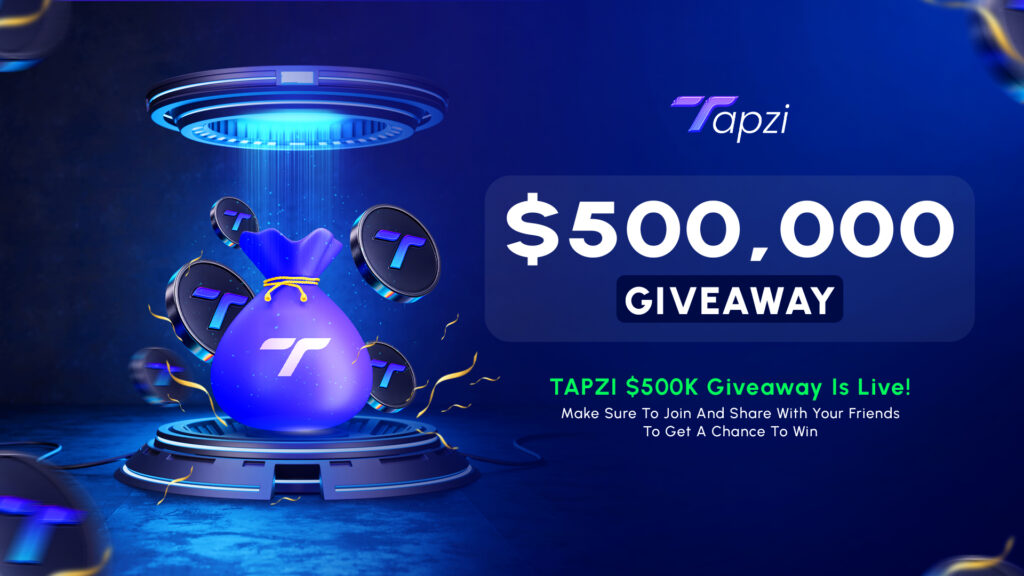6 Secret Presales Poised for 1000x Gains

Finding the best new crypto presale to buy in 2025 is harder than ever. The market is overflowing with new projects, and while large-cap tokens dominate headlines, true upside often comes from presales quietly building real foundations, shipping code, growing networks, and launching mainnets before the crowd notices.
This guide cuts through the noise. It’s a curated list of the best new crypto presales to buy right now, chosen for clear signals: strong utility, active teams, and real market demand. Some are scaling Layer-2 infrastructure, others are bridging blockchain with real-world use cases. A few lean on meme-driven communities, while others focus on serious tools and infrastructure.
Here are six standout projects worth watching and potentially backing early:
- Tapzi ($TAPZI) – Web3 skill-gaming platform for real-time PvP competitions with prize pools.
- Best Wallet Token (BEST) – Access token for exclusive presales and early listings.
- Harry Hippo (HIPO) – Web3 gaming and staking experience with vibrant branding.
- Guardians of the Car (GOCAR) – Memecoin meets automotive tech.
- Cogni AI (COGNI) – AI chatbots + blockchain infrastructure for automation.
- SpacePay (SPY) – Multi-chain payments infrastructure for Web3 commerce.
You don’t need to buy them all. Tracking four or five strong presales gives you both strategic exposure and high-upside potential. In the next section, we’ll dive deep into each project, its utility, roadmap, tokenomics, and community momentum. No fluff. Just functional potential. And among them, Tapzi may be one of the rare few combining skill-based competition, fair gameplay, and strong presale performance.
List of Top Next 1000x Presales You Should Participate in Now
Tapzi ($TAPZI)
Tapzi positions itself as the first Web3 gaming platform built entirely around skill. While most blockchain games lean on random rewards, speculative tokenomics, or grind-heavy play-to-earn loops, Tapzi sets out to remove luck from the equation. Every match on the platform is designed so that the better player wins, not the one who simply has more time or capital to spend.
At its core, Tapzi runs real-time player-versus-player matches across a set of simple, universal skill games such as Chess, Checkers, and Rock-Paper-Scissors. Players enter these matches by staking the platform’s native token, $TAPZI, with entry fees ranging from just 1 token to 1,000 tokens. Matches last around 5 to 15 minutes, and the winner immediately receives the prize pool funded by both players’ stakes. Returns can range from +10% to +200% depending on the tier and opponent difficulty.

1000x Potential Awaits – Tapzi Presale at Just $0.0035!
To keep competition fair, Tapzi uses an ELO-based ranking system to pair players of similar ability. It also integrates anti-cheat protections and active monitoring to detect suspicious behavior or bots, with enforcement designed to preserve the integrity of the ecosystem. The goal is to create a space where new players can compete confidently without worrying about exploits, manipulation, or unfair advantages.
The platform’s design also leans on accessibility. It’s available on web, mobile browsers, and progressive web apps, supporting major blockchains including Ethereum, BNB Smart Chain, Polygon, Arbitrum, and Solana. Tapzi has integrated credit card on-ramps to simplify onboarding, lowering the barrier for users who are new to crypto wallets.
Economically, Tapzi runs on a fixed token allocation model: 20% of the total supply is reserved for presale, while the rest is split across liquidity, team, treasury, airdrops, development, marketing, and rewards. Presale tokens are released gradually, 25% at the token generation event (TGE), with the remaining 75% vested over time. Team tokens are locked for a full year with no initial release, while liquidity and treasury allocations are also locked to reduce early dumping risk.
The project highlights its security credentials through audits by Coinsult and Solidproof, and the team has completed KYC verification. By combining competitive gameplay, transparent mechanics, and accessible onboarding, Tapzi aims to carve out a new model in Web3: a gaming economy built on fairness, skill, and trust rather than speculation.
Best Wallet Token (BEST)
Best Wallet Token ($BEST) is more than just another presale; it’s a utility layer for one of the most widely used non-custodial wallets in the crypto space. Built on Ethereum, $BEST is currently accessible only to existing Best Wallet users, giving early adopters exclusive access before it hits the public market.
What sets this token apart and makes it a strong contender for the next 1000x presale to buy now is its built-in user base and real-world application. Instead of launching without purpose, $BEST is already embedded in an active ecosystem, where it reduces transaction fees, boosts staking APYs via its aggregator, and grants holders governance rights.
By participating in this gated presale, early users are not just buying a token; they’re upgrading their experience across the entire Best Wallet platform. With over $10.7 million raised and a time-limited window before public release, the demand is already signaling confidence.
Add to that multi-asset payment options (ETH, BNB, USDT, cards), and $BEST becomes one of the most practical and ecosystem-integrated tokens currently in presale.
Harry Hippo (HIPO)
Harry Hippo ($HIPO) blends meme energy with real gaming mechanics to deliver one of the most unique presales in the GameFi space. It powers Harry Hungry Hipo, a blockchain-based play-to-earn game where players compete, earn, and stake all within a fun, hippo-themed universe.
What really turns heads is the fixed 601% APY staking reward during the presale. Unlike most P2E projects that offer vague future incentives, $HIPO gives early participants a clear and immediate reason to lock in. With 20% of the 3 billion supply allocated for staking rewards, the system is built to reward those who believe early.
But the vision doesn’t stop at gameplay. The roadmap includes AI-driven P2E analytics and NFT integrations, pushing the project toward a broader GameFi metaverse. As Ethereum-based ERC-20 tokens continue gaining traction, $HIPO’s accessibility via ETH, USDT, BNB, and even card payments makes onboarding easy for new players and crypto natives alike.
With $1.2 million raised and rising attention, Harry Hippo stands out as a fun-first yet utility-driven coin that could easily be one of the next 1000x presales to buy now.

Guardians of the Car (GOTCAR)
Guardians of the Car ($GOTCAR) is a bold fusion of Web3, AI, and automotive safety. As the first car-themed meme coin with real-world application, $GOTCAR drives beyond the typical crypto narrative, aiming to eliminate traffic accidents through intelligent blockchain-powered tools.
At its core, GOTCAR deploys AI Agent services that tap into live data from its network of users called Guardians. These AI agents offer smart alerts like forward collision warnings, signal violation notices, and even real-time road hazard analysis based on weather conditions. Over time, the system evolves autonomously, refining its accuracy with every new data point.
But what makes it a potential next x1000 presale to buy now isn’t just the tech. It’s the positioning: $GOTCAR sits at the intersection of mobility, safety, and decentralization, all packaged in meme coin virality. As the first mover in the “car meme” space, it leverages humor and community power while building tools that could reshape urban driving and autonomous safety systems.
With a mission that’s both playful and purposeful, GOTCAR offers an opportunity to back a project that’s as disruptive as it is entertaining.
Cogni AI (COGNI)
Cogni AI ($COGNI) is transforming the way tokens are created and launched by giving that job to AI agents. Unlike traditional platforms that require complex tools or technical teams, Cogni AI introduces a system where intelligent chatbots handle everything from token generation to community interaction, all backed by blockchain.
At the heart of the project is the Cogni.fun AI Agent Token Generator, an autonomous platform built on advanced AI codebases like AI16Eliza and vvaifu.fun. These AI agents aren’t just for show; they actively launch, manage, and distribute tokens, interact with users, and even support DeFi features like staking and rewards. It’s a fully automated solution with 24/7 operation and minimal human oversight.
This makes $COGNI a prime x1000 presale opportunity: it combines token utility, AI automation, and blockchain security into a single scalable ecosystem. Whether for gaming, marketing, finance, or community governance, Cogni’s tools are designed to make token creation not just easier but smarter.
By bridging the gap between conversational AI and crypto infrastructure, Cogni AI isn’t just launching tokens; it’s launching a new standard for how they’re built and scaled.
SpacePay (SPY)
SpacePay ($SPY) is laying the groundwork for what could be the future of crypto payments at the point of sale. Rather than aiming to replace traditional systems from the top down, it focuses on practical integration, starting with NFC-based crypto payment tools that are as easy to use as a tap.
As a UK-based FinTech project, SpacePay is bridging the gap between decentralized assets and real-world commerce. Its flagship product, the SpacePay Payment APK, is built for real-life usage: enabling stores, retailers, and users to pay or accept crypto with speed, reliability, and a user-friendly design.
What makes $SPY a next x1000 presale to buy now isn’t just the tech, it’s the timing and infrastructure. With only 20% of the total supply allocated for presale, and $889K already raised, early adopters are stepping in before public exposure. A full audit is also planned before launch, signaling a clear commitment to security and trust.
$SPY is launching an entire ecosystem, including API integrations for commercial applications, wallet compatibility, and real-time transaction support. If crypto is ever going to go mainstream in retail, SpacePay may be the company to make it happen.
The Smart Way to Play Presales
In 2025, the crypto market rewards precision. Noise dominates headlines, while real upside often hides in presales quietly shipping code, building networks, and launching mainnets under the radar. The projects that break out aren’t the loudest; they’re the ones solving real problems while no one’s looking.
The six projects here, Tapzi, Best Wallet Token, Harry Hippo, Guardians of the Car, Cogni AI, and SpacePay, stand out because they’re building something tangible, not just hype. They show clear signals of utility, team momentum, and market need. Some are creating infrastructure, some are weaving blockchain into real-world value, and others are building vibrant communities around their ecosystems. That mix of function and traction is rare, and valuable.
You don’t need to back them all. Focus on a few. Track their presale phases, read their whitepapers, watch their communities, and look for real progress, not just promises. The goal isn’t to be early everywhere. It’s to be right once, at the right time. That single move can outweigh dozens of misses.
Diversifying across four or five strong presales isn’t about guessing; it’s about positioning. If just one of them breaks through, it can deliver the kind of exponential upside this market is known for. And beyond returns, following these projects teaches you how new markets take shape in real time, while most are still focused on the noise.
Presales will always be noisy. But inside that noise are signals, and spotting those signals before the crowd is where outsized gains begin. This list isn’t a forecast; it’s a snapshot. What you do with it depends on how closely you follow, question, and keep showing up.
You May Also Like

VeChain Releases VeWorld v2.4.10 With Major Token Exploration Upgrades

Justin Sun: Over 95% of the USDJ supply has been bought back at a premium, leaving only about $200,000 worth of USDJ on the market.
